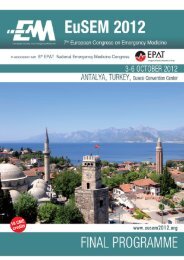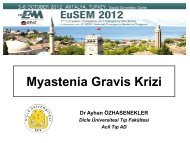Forensic Medicine and Disaster: Victim identification - EUSEM 2012
Forensic Medicine and Disaster: Victim identification - EUSEM 2012
Forensic Medicine and Disaster: Victim identification - EUSEM 2012
You also want an ePaper? Increase the reach of your titles
YUMPU automatically turns print PDFs into web optimized ePapers that Google loves.
Identification issues in mass casualty<br />
Nagi Souaiby, MD, MPH, MHM<br />
Emergency, <strong>Forensic</strong> <strong>and</strong> <strong>Disaster</strong> <strong>Medicine</strong> specialist<br />
Saint Joseph University (USJ) – Beirut – Lebanon<br />
WHO Expert<br />
National School or Emergency Care - Director<br />
Lebanese Resuscitation Council - President<br />
Lebanese Society of Emergency <strong>Medicine</strong> – Former president<br />
Oct. 4-6, <strong>2012</strong> – EuSEM
Mediterranean Journal of Emergency <strong>Medicine</strong><br />
www.newhealthconcept.net<br />
No potential conflict of interest for this lecture
Feb 14 2005
2005 – 2008: 2 wars<br />
<strong>and</strong> more than 14 criminal explosions
A disaster is an unexpected event<br />
causing the death of<br />
many people….<br />
….but also the admission to the ED/ICU<br />
of unconscious injured patients<br />
Thus DVI operations may be required
Outline<br />
Global approach of disaster management<br />
<strong>Disaster</strong> <strong>Victim</strong> Identification<br />
Specific Legal issues (forensic)
<strong>Disaster</strong> <strong>Victim</strong> Identification<br />
Humanitarian issue to families & relative<br />
It’s a duty of the society / international<br />
community.
Key message of this lecture<br />
The most important<br />
requirement for victim<br />
<strong>identification</strong> work is the<br />
application of international<br />
st<strong>and</strong>ards, which are the<br />
common basis for the work in<br />
multinational DVI operations
DVI: International st<strong>and</strong>ards<br />
(Interpol)<br />
Require strict methodology on scene &<br />
in <strong>Forensic</strong> institute<br />
Specific religious, cultural needs <strong>and</strong><br />
national laws <strong>and</strong> directives of the<br />
concerned country must be taken into<br />
consideration.
<strong>Disaster</strong> Plan<br />
Emergency Contingency Plan<br />
Chief Comm<strong>and</strong>ant<br />
Director of Rescue Operations<br />
…..<br />
<strong>Disaster</strong> <strong>Victim</strong> Identification Teams<br />
…..<br />
Director of Public Relations
Issued from the Interpol Guide
Body Recovery
Mortuary Branch
Identification<br />
Center
DVI teams work in an<br />
interdisciplinary manner <strong>and</strong><br />
engage the services of experts in<br />
various different fields, as needed.<br />
Issued from the Interpol Guide
DVI Guidelines<br />
Positive <strong>identification</strong> of victims<br />
Highest possible quality st<strong>and</strong>ards<br />
<strong>Victim</strong>s are to be treated with dignity <strong>and</strong> respect,<br />
Interpol forms should be used to document<br />
victim <strong>identification</strong><br />
AM (ante mortem)<br />
PM (post mortem) data
<strong>Disaster</strong> typology / classification<br />
Open disaster: major catastrophic event<br />
resulting in the deaths of a number of<br />
unknown individuals for whom no prior<br />
records or descriptive data are available.<br />
Closed disaster: major catastrophic event<br />
resulting in the deaths of number of<br />
individuals belonging to a fixed, identifiable<br />
group.
Concorde Crash July 2000<br />
Tsunami<br />
Before<br />
After
<strong>Disaster</strong> <strong>Victim</strong> Identification<br />
Accurate mapping of the disaster area:<br />
GRID<br />
If wide disaster area, aerial photography
Aircraft Crash scene
methods of <strong>identification</strong><br />
Primary<br />
Secondary<br />
Certitude elements of<br />
evidence<br />
Probable elements of<br />
evidence
Primary methods of <strong>identification</strong>:<br />
Fingerprint<br />
analysis<br />
<strong>Forensic</strong> dental<br />
analysis<br />
DNA analysis
Secondary methods of <strong>identification</strong>:<br />
Personal descriptions /<br />
medical findings<br />
Evidence / clothing
Identification of the fire victim<br />
Fire may be very destructive,<br />
No or little material available for<br />
<strong>identification</strong>,<br />
Metal prosthesis,<br />
Teeth<br />
Some soft tissues / tongue<br />
Skeletal radiology
Dental examination<br />
Dental Record : AM / PM ++++<br />
Survives incineration very well,<br />
Accurate, reliable <strong>and</strong> legally acceptable<br />
<strong>identification</strong><br />
Results of AM data can be computerized:<br />
digital radiographs can be easily stored in<br />
a central archive, retrieved <strong>and</strong><br />
transmitted, via modem, to mass casualty<br />
sites (Gruber j, Kameyama MM 2001).
X-ray<br />
Estimation of age is required,<br />
Discover fractures or other unique<br />
<strong>identification</strong> information<br />
Locating <strong>and</strong> identifying evidential material<br />
(prosthesis, bullets or bomb fragments)<br />
X-ray equipment, preferably portable,<br />
should always be made available in the<br />
mortuary
Metal prosthesis<br />
Plate in a long bone
Comparative dental<br />
<strong>identification</strong> by radiology
Genetic <strong>identification</strong><br />
An individual's genetic data is the same in all his or<br />
her cells <strong>and</strong> remains constant even after death<br />
Complement other methods especially if body<br />
severely mutilated / burned<br />
Biological sample analysis can result in:<br />
The genetic linking of a victim to members of his<br />
natural family<br />
The conclusion that victims were not related<br />
The matching of body parts<br />
It must be remembered, however, that attempts to link a victim with his<br />
father or children involve the risk of proving non-paternity
Collection of post mortem samples Interpol recommendations<br />
Condition of body Recommended sample<br />
Complete, non-decomposed corpse Blood (on FTA paper or swab)) <strong>and</strong> buccal (oral)<br />
smears<br />
Mutilated, non-decomposed corpse If available: blood <strong>and</strong> deep-seated red muscle<br />
tissue (~1.0g)<br />
Complete, decomposed corpse or<br />
mutilated remains<br />
Sample from long, compact bones ( 4-6 cm<br />
sections, window section, without shaft<br />
separation)<br />
Or.<br />
Healthy teeth (preferably molars)<br />
Or.<br />
Any other available bone (~10g, if possible;<br />
preferably cortical bones with dense tissue)<br />
Severely burnt corpses All samples listed above <strong>and</strong> impacted teeth or<br />
tooth roots if present<br />
or<br />
smears from the gold bladder
Conclusion<br />
Social cultural, religious & economic<br />
problem<br />
No place for improvisation<br />
Must be as quick as possible<br />
Must be held by senior experts
Examples
Lockerby (21/12/1988): 259 victims,<br />
2 Km2, 28 days for <strong>identification</strong>,
Sc<strong>and</strong>inavian Star: 7/4/1990: 158<br />
burned victims, 17 days,
Noronic (Toronto)<br />
1949: 4 months to<br />
identify 115 /118<br />
victims (524<br />
passengers)
Thank you<br />
Byblos the oldest city in the world




